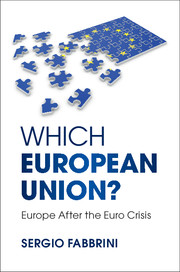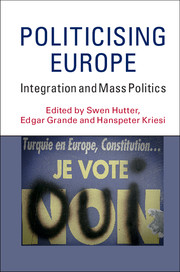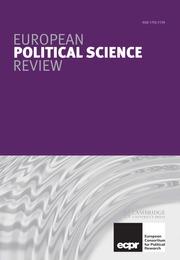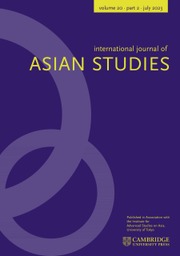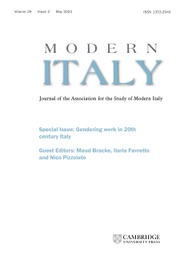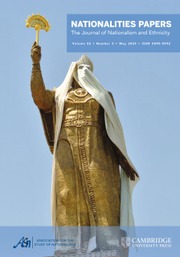Which European Union?
Europe after the Euro Crisis
- Author: Sergio Fabbrini, Libera Università Internazionale degli Studi Sociali Guido Carli, Roma
- Date Published: February 2015
- availability: Available
- format: Hardback
- isbn: 9781107103948
Hardback
Other available formats:
Paperback, eBook
Looking for an inspection copy?
This title is not currently available for inspection. However, if you are interested in the title for your course we can consider offering an inspection copy. To register your interest please contact [email protected] providing details of the course you are teaching.
-
Sergio Fabbrini argues that the European Union (EU) is made up of states pursuing different aims, rather than simply moving in the same direction at different speeds. He describes the alternative perspectives on the EU (an economic community, an intergovernmental union, and a parliamentary union), that led to multiple compromises in its structure and shows how the Euro crisis has called them into question. The book argues that a new European political order is necessary to deal with the consequences of the crisis, based on an institutional differentiation between the EU member states interested only in market co-operation and those advancing towards a genuine economic and monetary union. Such a differentiation would allow the latter group to become a political union, conceptualised as a compound union of states and citizens, while preserving a revised framework of a single market in which both groups of states can participate.
Read more- Proposes a new way of looking at the European Union
- Reflects the very different perspectives on integration within the EU
- Analyses how the Euro crisis has transformed the structure and function of the EU
Reviews & endorsements
'Fabbrini brings to bear the skills of a seasoned analyst of comparative politics, a sophisticated knowledge of the federalism literature, and a deep familiarity with the workings of the EU. This book will surely animate a lively debate about where the EU has been and how it can develop in the future.' James A. Caporaso, University of Washington
See more reviews'In this conceptually sophisticated and historically erudite study, Sergio Fabbrini offers a highly original reinterpretation of the European construct and the structural causes of its current crisis. Supported by outstanding scholarship, his vision of multiple but connected Unions as the best way to escape Europe's current conundrum is bound to become a critical referent in today's debates over the trajectory of the European project.' Kalypso Nicolaïdis, University of Oxford
'Which European Union? is a rare combination of truly comparative breadth and impressive analytic structure which make this book a 'must read' for those interested in the European Union. Its comparative focus on 'multiple separation of powers systems' identifies the EU as belonging to that group of political systems in which the government is a process rather than an institution. Fabbrini thereby suggests a new theoretical approach to explaining why the EU works as it does.' Alberta M. Sbragia, University of Pittsburgh
'The Eurozone needs further integration, not so the common market. A new plural architecture is needed to preserve the distinct features of the two main clusters of the EU and at the same time to give them a common framework. If we don't want to go back, the way forward suggested by this book deserves the highest attention.' Giuliano Amato, former Italian Prime Minister and Vice-President of the Brussels Constitutional Convention
'[Which European Union?] correctly puts an emphasis on the role of Sarkozy and Merkel in dealing with the crisis, while other EU actors were partially marginalised.' Davide Vittori, The International Spectator
Customer reviews
Not yet reviewed
Be the first to review
Review was not posted due to profanity
×Product details
- Date Published: February 2015
- format: Hardback
- isbn: 9781107103948
- length: 376 pages
- dimensions: 229 x 155 x 25 mm
- weight: 0.67kg
- contains: 8 b/w illus. 19 tables
- availability: Available
Table of Contents
Preface: how many Unions?
Part I. Institutionalisation of Multiple Unions:
1. From Rome to the Lisbon Treaty
2. The Lisbon Treaty and the Euro Crisis
3. Institutionalisation and constitutional divisions
Part II. Main Perspectives on the European Union:
4. The perspective of the economic community
5. The perspective of intergovernmental union
6. The perspective of parliamentary union
Part III. Towards the Compound Union Perspective:
7. Comparing democratic models
8. Compound unions and the EU
9. A new political order in Europe.
Sorry, this resource is locked
Please register or sign in to request access. If you are having problems accessing these resources please email [email protected]
Register Sign in» Proceed
You are now leaving the Cambridge University Press website. Your eBook purchase and download will be completed by our partner www.ebooks.com. Please see the permission section of the www.ebooks.com catalogue page for details of the print & copy limits on our eBooks.
Continue ×Are you sure you want to delete your account?
This cannot be undone.
Thank you for your feedback which will help us improve our service.
If you requested a response, we will make sure to get back to you shortly.
×
